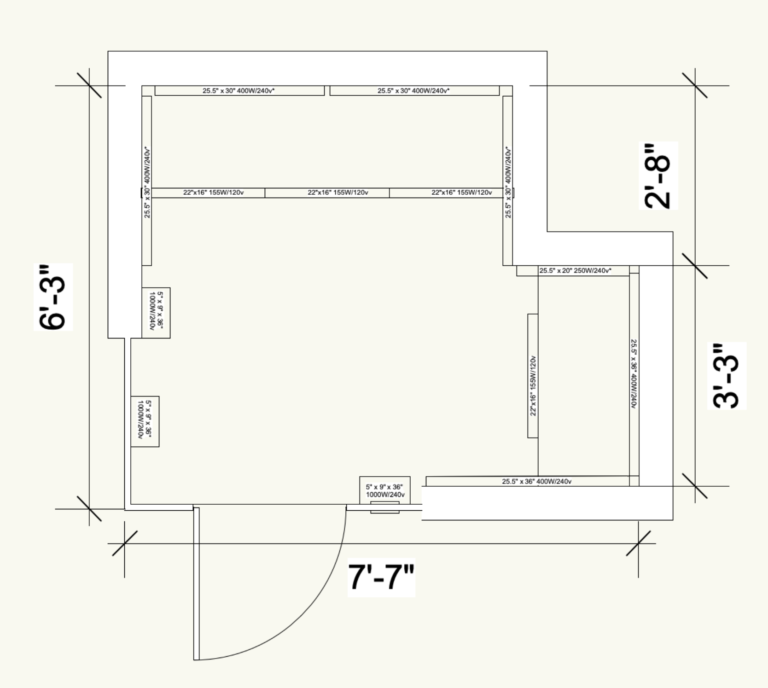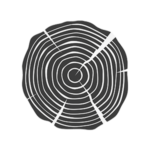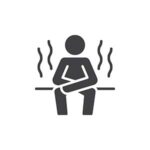Build Your Infrared Saunas - DIY Infrared Sauna
If you have the means and desire to build your own diy infrared sauna, there is no better way to get exactly what you want than by designing your own. In fact, I would design my own sauna over purchasing a pre made infrared sauna one hundred percent of the time. However, there are some things to know before you dive in on your own.
Before I built my own infrared-sauna and wrote this infrared sauna kit tutorial, I did a lot of research. I looked into the types of wood and what infrared light source penetrates deepest. I concluded I would need some professional help.
This turned out to be a great success as I got exactly what I needed. The price was the same as purchasing one of the biggest portable units on the market.
Key Takeaways:
• It is impossible to heat a diy-infrared sauna properly and get amazing health benefits without “Full Spectrum sauna” heaters. You need high-powered heat.
• You can’t buy an all-in-one sauna carbon panel heater kit that will fit your sauna perfectly. It won’t heat your space adequately.
•Cedar wood is the best. It is resistant to warping and cracking as there is a broad range of temperatures in saunas. It’s also naturally anti-bacterial and anti-fungal.
• Warranty length is important. Companies dictate the length of their warranty with how long they believe their heaters will last.
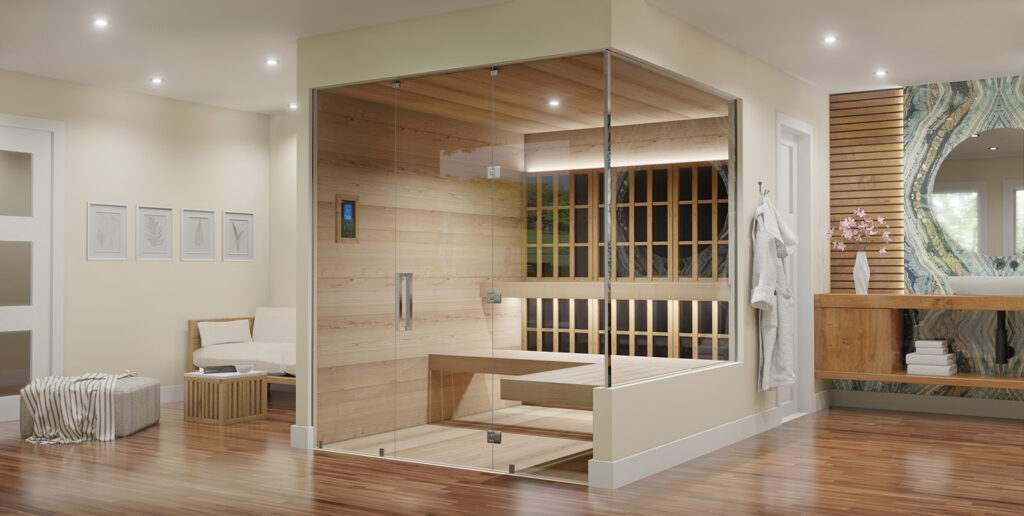
Should You Build Your Own Infrared Sauna?
Over the last eight years I’ve sold thousands of custom infrared saunas in every variation. From traditional sauna retrofits to walk-in closet sauna conversions. I have also done hot yoga studio saunas, outdoor infrared saunas and new construction.
Each has their challenges. The first thing you must do is understand how your room will perform as an infrared-sauna. Does it have four walls? Does it have a door? How high is the ceiling? Is the floor and ceiling flat?
The most important thing to know is that infrared saunas work better in smaller spaces. Lower ceiling heights (of 7′ to 8′ maximum) work the best. Bigger rooms are definitely doable (and we have done 28′ x 28′ x 9′ infrared rooms). However, they aren’t as ideal as you need to be closer to the infrared-heaters to get the heavy metals detoxing benefits.
I aim to help you make your own sauna correctly so you can get so many other great light therapy benefits that include, better blood circulation, pain relief, faster wound healing, a boosted immune system and so much more.
Where do you want your new custom sauna to go?
Before you decide to go ahead and build your own infrared-sauna you will want to decide where you want it to go. You can use any space to design and fit your infrared-sauna into. Yet, my suggestion for your sauna would be an extra bathroom, an unused laundry room or walk in closet.
I had a couple of options, myself. I wanted to use the smaller of two spaces I had available. I decided upon an extra closet as opposed to taking over one of my extra bathrooms. The closet was a nice size – 5’ x 7’ x 10’. It was windowless but still had enough room for a deep bench and floor space.
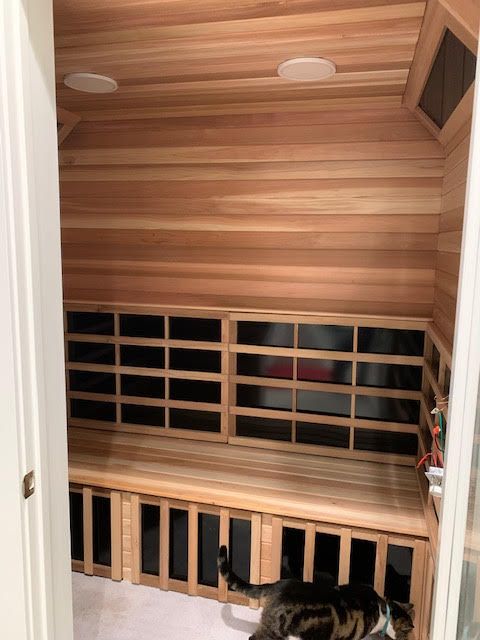
You can also…
Convert an existing hot rock sauna into infrared
A lot of people have old hot rock saunas from the 1970’s that need a serious upgrade. Infrared-heaters can easily be placed into a sauna that used to be a traditional/hot rock sauna. The caveat is that traditional saunas tend to be a bit bigger than infrared. Be aware that you will need a 240 volt line and may have to do a bit of woodworking.
Old hot rock saunas usually have nice, clear tongue and groove cedar wood that can be sanded if there are old sweat stains. Not having to replace the wood on the walls will save a lot of money on upfront cost.
What is the height of your ceiling?
Infrared works by raising your core temperature. You need to have the air temperature in the 110 – 125°F range. If your ceilings are above 8 feet, the hot air will rise and not allow for the room to properly heat.
I always recommend framing the room off and installing a drop/false ceiling so it is no higher than 8 feet. Ideally, you would do 7 or 7.5 feet. I chose 7.5’ and added a few extra watts.
New Construction
About half of the custom infrared saunas we do are a newly constructed house, day spa, gym or apartment complex. The thing most architects do wrong is make the space for the sauna too large. You heard me right. You want to keep the dimensions of the room a bit smaller for infrared. 6′ x 8′ or 8′ x 8′ would be about the limit.
Make sure that when you are designing your sauna you take into account that tongue and groove wood takes up 1″ on all walls. This will make the interior dimensions 1″ smaller.
DIY Sauna Configuration and Dimensions DIY Sauna Configuration and Dimensions
Decide On Your Door Location and Size
Decide On Your Bench Location(s)
The bench locations are as important as anything in your sauna as it’s where you’ll be spending all of your time. So you better be comfortable.
Why Western Red Cedar Wood is Best Why Western Red Cedar Wood is Best
Why Wood Matters Within Infrared Saunas
The type of wood makes a difference in how well the sauna will age, and how well it will stand up to repeated use. The wood type will also determine how clean it will stay over time.
Many woods are too soft to use in a sauna environment (like Hemlock and Poplar) or too low in strength (like Pine). There are also hardwoods like Eucalyptus, which are too stiff to handle the constant heating up and cooling down in the sauna.
Why Western Red Canadian Cedar Wood is Best
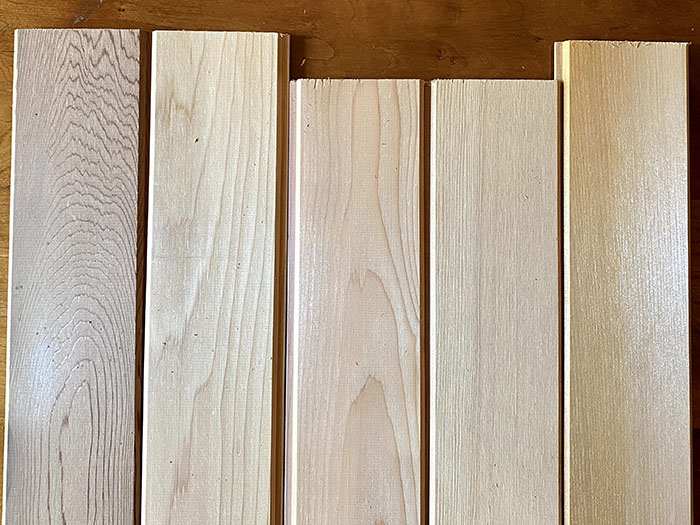
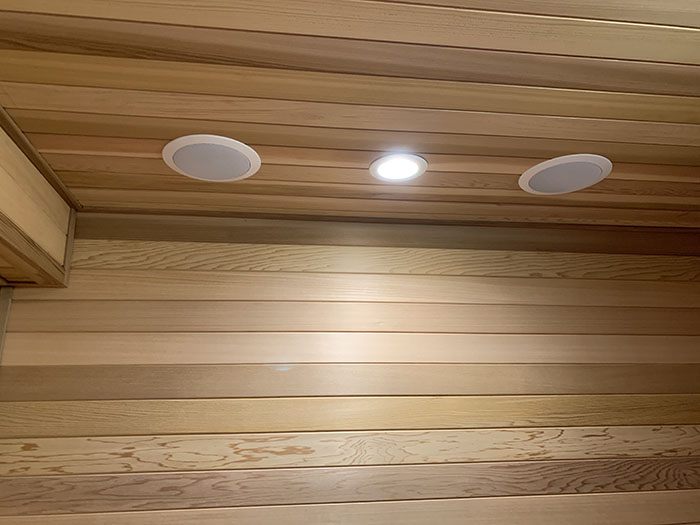
Western Red Canadian Cedar Wood is among the softest wood available for saunas. This makes it the best for custom sauna applications as it doesn’t warp or crack. Saunas vary widely in temperature. In the Winter they are frozen. In the Summer, they stay hot. Protecting from cracking (and leaking) are important.
Very often we do a traditional/hot-rock sauna conversion to infrared where the wood is from the 1970’s and it is in perfect condition. If cared for, it lasts forever.
Infrared saunas are dry (unlike traditional steam saunas). This reduces the likelihood of fungal and bacterial growth. However, antiseptic wood qualities are still desirable since a sauna is a place where you go to sweat. This brings moisture, fungus and bacteria.
Cedar is antimicrobial and antibacterial, which prevents the growth of fungus or other allergens. No other wood keeps itself cleaner in a sauna.
Because of Cedar’s hardiness in wet conditions (and its natural ability to repel insects), it has been the choice of traditional steam saunas for hundreds of years–even outdoors.
It also has the classic cedar smell–need I say more?
Why You Need Full Spectrum DIY Why You Need Full Spectrum DIY
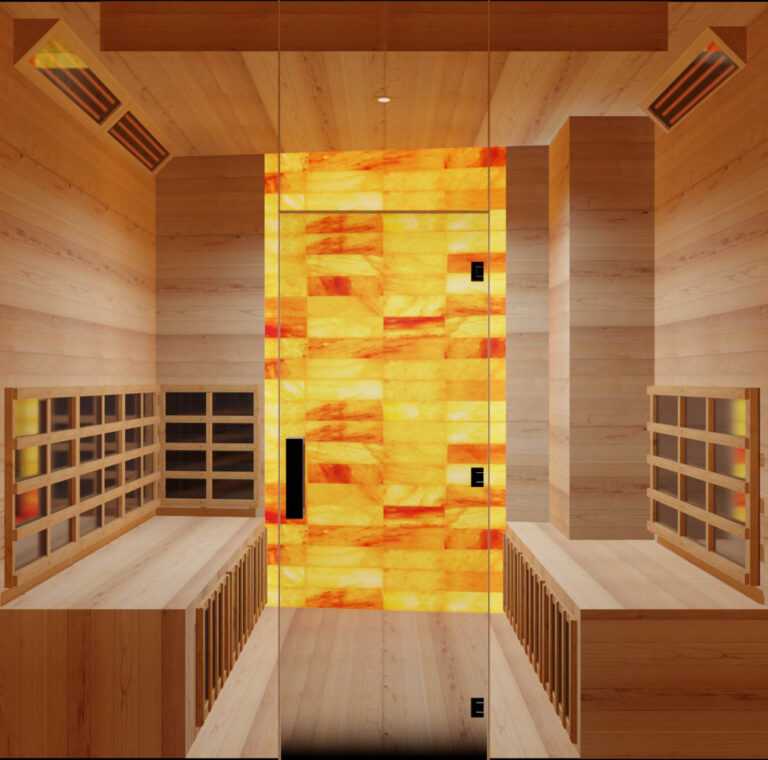
The Importance of Heater Surface Temperature
You can not heat a custom infrared space that is larger than 3.5′ x 3.5′ x 7′ without full-spectrum infrared heaters.
If you purchase an all in one heater kit that is only carbon heaters, you are bound to be disappointed.
How near, mid and far infrared works
The surface temperature of the heater is going to determine the infrared wavelength that is absorbed into your body. The longer the wavelength, the more infrared can be absorbed.
The most important factor for receiving health benefits in an infrared sauna is raising your core body temperature and sustaining a sweat for 30+ minutes. This is the entire goal!
As a result, your body will excrete toxins, you will lose weight and recycle old cells. You must have a sauna that gets hot. The best surface temperature to heat your body and penetrate deep into your tissue is 200 °F.
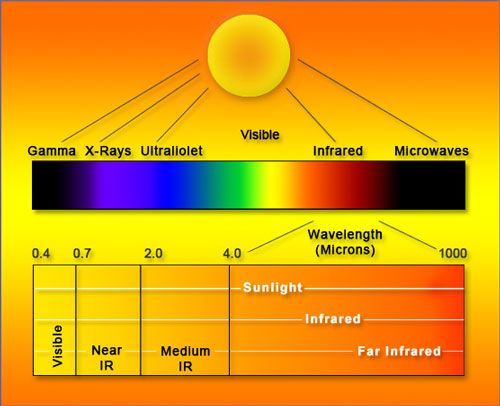
Wien’s Law of displacement dictates the infrared wavelength measured in microns based on a surface temperature.
Here is the formula:
5268 / (input temp °F + 460) = peak emission wavelength [PEW] in microns
The PEW is actually an inverse of surface temperature to wavelength. The hotter the surface of an object, the shorter the wavelength. The inverse is true as well. As we get a higher micron level, the surface temperature drops and the wavelength becomes longer.
Near Infrared
There are “near infrared saunas” advertised out there. As demonstrated above, there is actually no near-infrared being produced by these saunas. For that reason, I don’t recommend them. They are not nearly as efficient or effective.
Near-infrared can be applied using LED lights (without heat). They do have proven health benefits. However, this is tough to do in a sauna environment as you have to be with 6″ of the LED’s to get any benefit.
Mid Infrared – The Forgotten Band
Mid-infrared is most definitely the least admired infrared light bandwidth of the three. Part of the reason for this is that there aren’t (currently) any mid-infrared sauna medical studies.
When sauna companies say that mid-infrared targets joint pain more than far-infrared they are pulling it out of thin air.
Mid-infrared is shown on our light chart in the range of 2-4 microns. This is still a very effective band of infrared light to raise your core body temperature. It is far more practical than near-infrared in a sauna.
In order to get mid-infrared you need to heat an infrared heater up to 850 °F minimum.
5268 / (850 °F + 460) = 4 microns (peak emission wavelength)
This really is the upper limit of what is comfortable to sit next to in a diy-infrared sauna application. However, if you sit 3′-4′ from the heater, the heat will have dissipated enough to be comfortable to sit close to while still raising your core temperature.
Far Infrared – The Game Changer
Far infrared saunas actually became popular much earlier than near infrared saunas. When it was discovered that you could skip a step by heating your body directly, (instead of the air and water between, like traditional and steam saunas), it was by using the far infrared wavelength.
The objective of an infrared sauna is to produce a deep and sustained sweat using whole body hyperthermia. Nothing more than that.
To raise your core body temperature, you must heat the body by using an optimal wavelength of light (the Peak Emission Wavelength). This results from the thermal radiation of an object (its surface temperature).
This is important because your body has a limit of the amount of heat it can take. For example, you can’t sit next to molten lava–you’ll die. Therefore, you need to find the balance of heat to comfort so you can sustain a great sweat over 30 minutes.
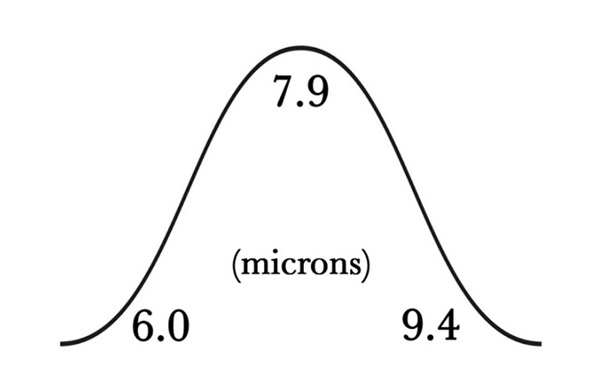
After 10 years of researching this intensively, I have concluded that this right around the 7.9-8.0 micron infrared range.
As you can see, the peak emission wavelength top is right at 7.90 microns. This means you are getting the most amount of heat at 7.9 microns (which is 185 F° on the surface of the heater).
You still have infrared waves traveling at 6.0 microns and wavelengths traveling at 9.4 microns. The heat is more intense measured right on the heater and dissipates as it gets further away. Hence the hotter (shorter) and cooler (longer) wavelengths.
Why is this important?
Near vs Far Infrared
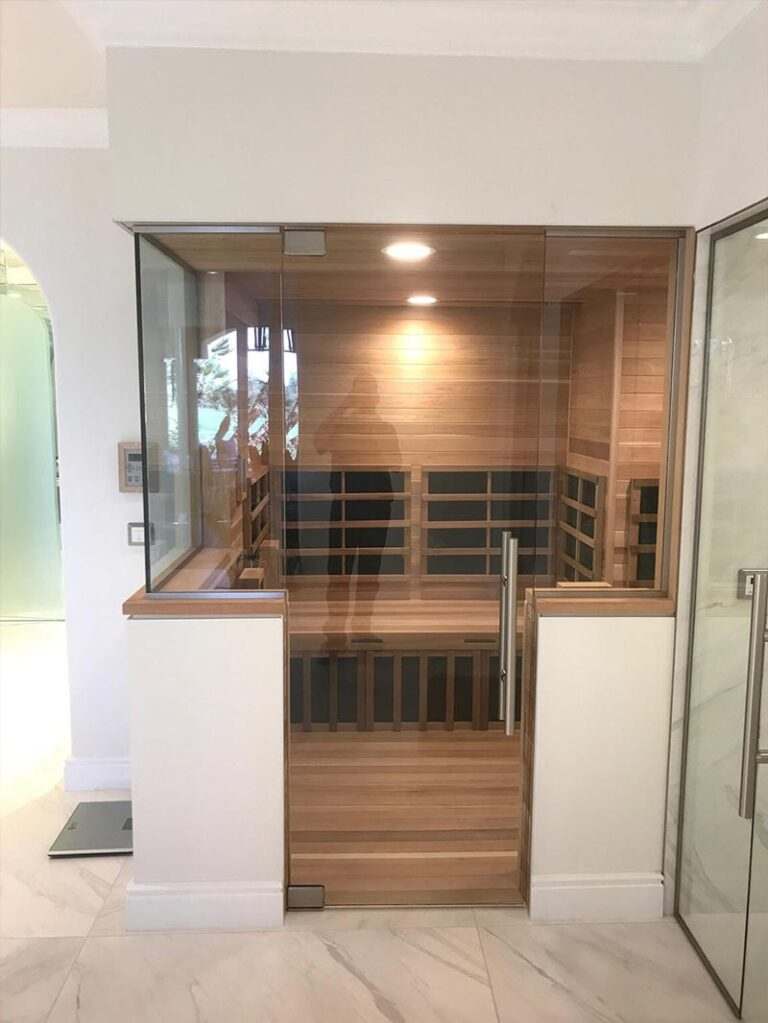
Why Choose VantaWave™ Heaters Why Choose VantaWave™ Heaters
VantaWave™ Quartz Graphite 200°F Heaters
Let’s input 200 °F into our formula:
5268 / ( 200 °F + 460) = 8 microns
This means that the infrared wavelength is pretty much right in the middle of carbon (9.4 microns) and ceramic (6.0 microns). The Peak Energy Wavelength of the quartz/graphite heater is 8 microns, but remember, this is just an average which can be expressed by a bell curve.

Why Carbon only panels don’t work
The VantaWave™ Solution
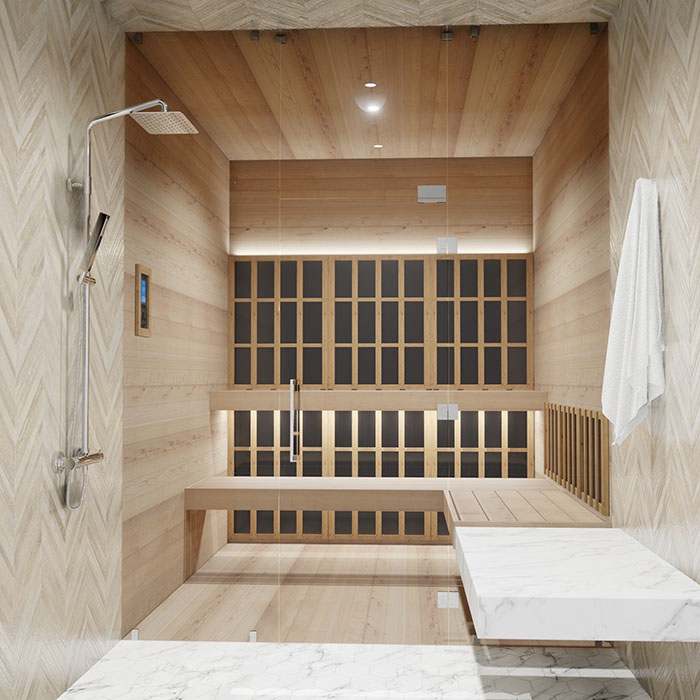
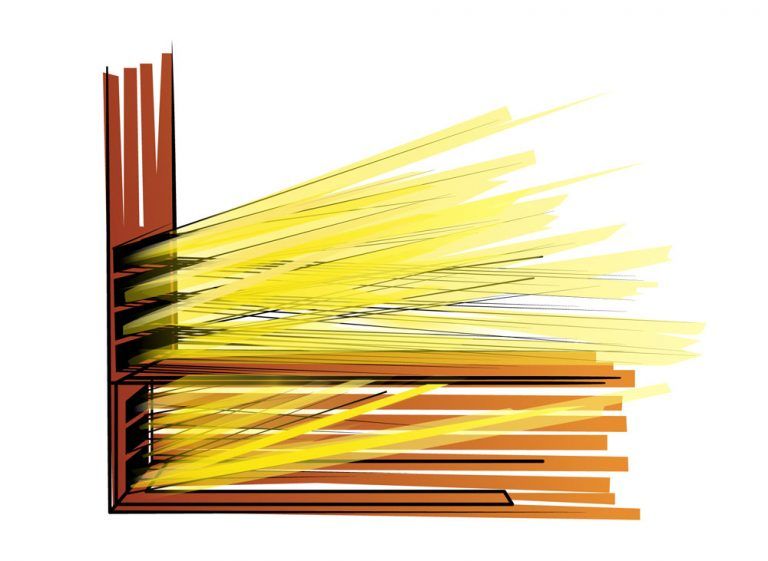
You get the best sweat possible whilst being able to sustain that sweat for over 30 minutes. In an infrared sauna, the more sweat, the better.
VantaWave™ Full Spectrum Halogen Heaters
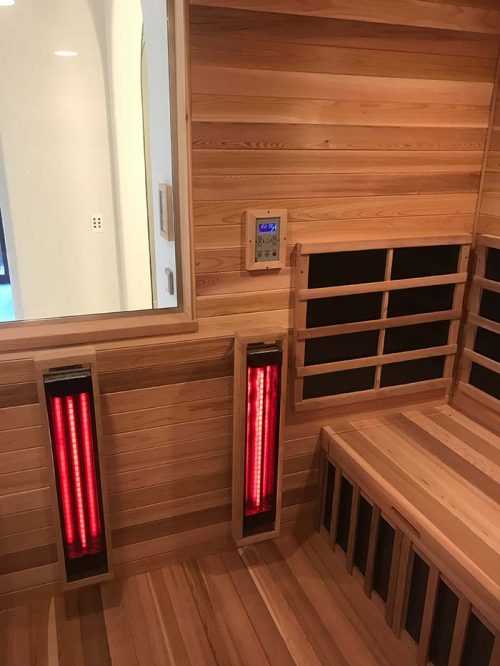
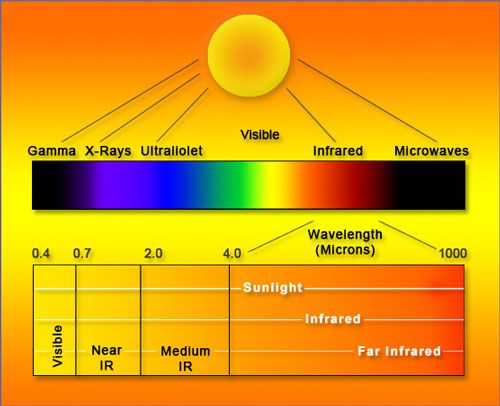
Building Your Infrared-Sauna DIY Building Your Infrared-Sauna DIY
Now that you’ve decided on your space and have laid out the door and bench locations, it’s time to construct your sauna. The following sections will guide you along your way.
Sauna Room Preparation
Take a look at the space in which you plan to install your very own infrared sauna–do not overlook how much space you need. Additionally, make sure you also have a licensed electrician there to install the electrical components and infrared lights.
It is important to take some time to think about these things before you start your own sauna. The list below is not exhaustive, and your general contractor or building inspector may have other considerations for the site at their discretion.
Is the sauna space already framed?
Before installing your own infrared sauna, you’ll need to frame the room. Make sure the dimensions of the space are in line with those listed on the spec sheet for sizing. Make sure to allow a 1″ on each wall for the tongue and groove wood. Always subtract one inch from each wall in the enclosed space.
The framing and bench wood will need to be purchased locally unless otherwise requested.
Is the sauna going to be near a room with running water?
Will your own infrared home sauna be near a bathroom or room with running water? This will require a vapor barrier to protect against leak-related damages in an adjacent room.
Are the walls insulated?
We recommend insulating your sauna space with a minimum of R-13 in the walls and backing the infrared bulbs with pre-cut insulation.
Is the sauna going to be built outside or have exterior walls?
Putting your sauna outside is completely optional. Should you choose to do it, you will want to make sure your sauna is insulated and waterproof.
You might also want to consider adding an additional heater to boost the overall wattage as it is much harder to keep your sauna extremely hot in the coldest part of the Winter.
Does the sauna have windows?
This requires that insulated tempered glass be installed. Sauna Cloud Infrared Saunas® does not supply windows. We recommend a minimum thickness of 10 mm tempered glass.
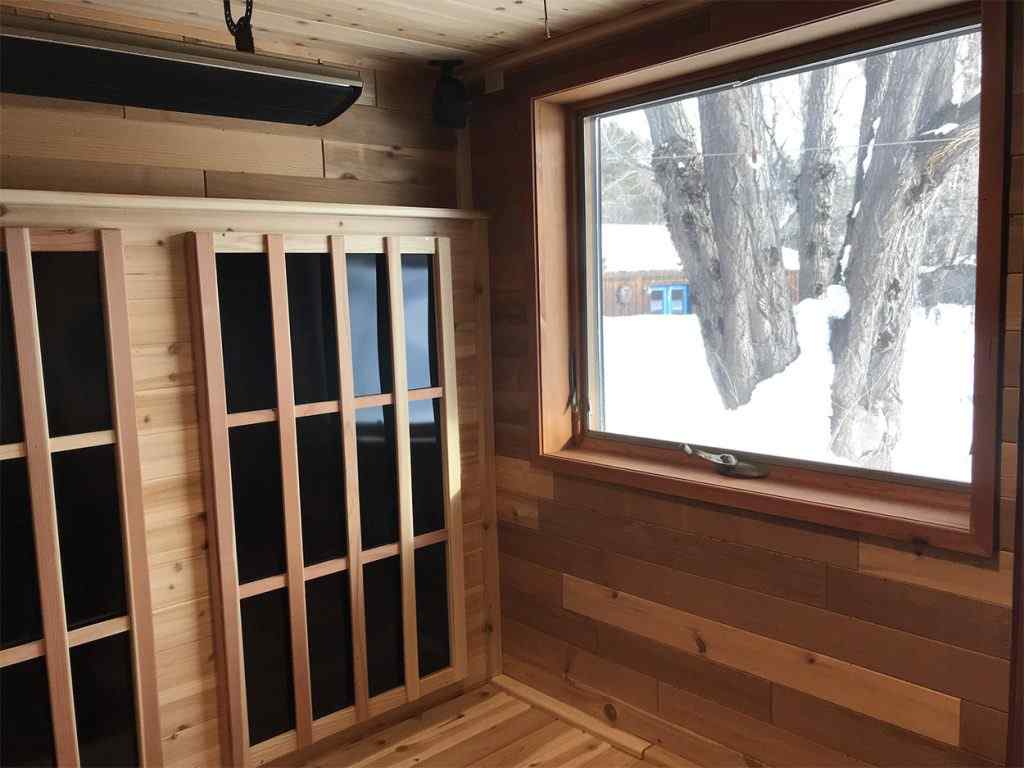
All Glass Front
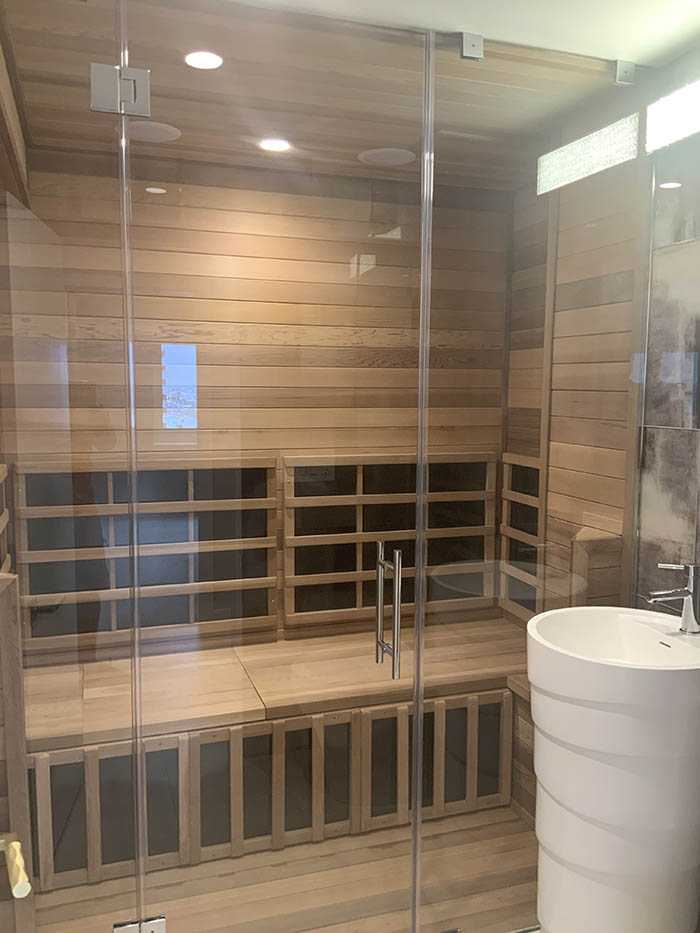
A lot of custom infrared saunas can look amazing with an all-glass front panel. If you go with this option, please get tempered glass (10 mm thick).
Wood Framing
Sauna Cloud Infrared Saunas® can provide Interior Wood T&G (Walls, Floors, and Ceilings) Bench Wood S4S (Bench Seat) and trim wood.
The benches are not prefabricated and will need to be constructed by the contractor on site.
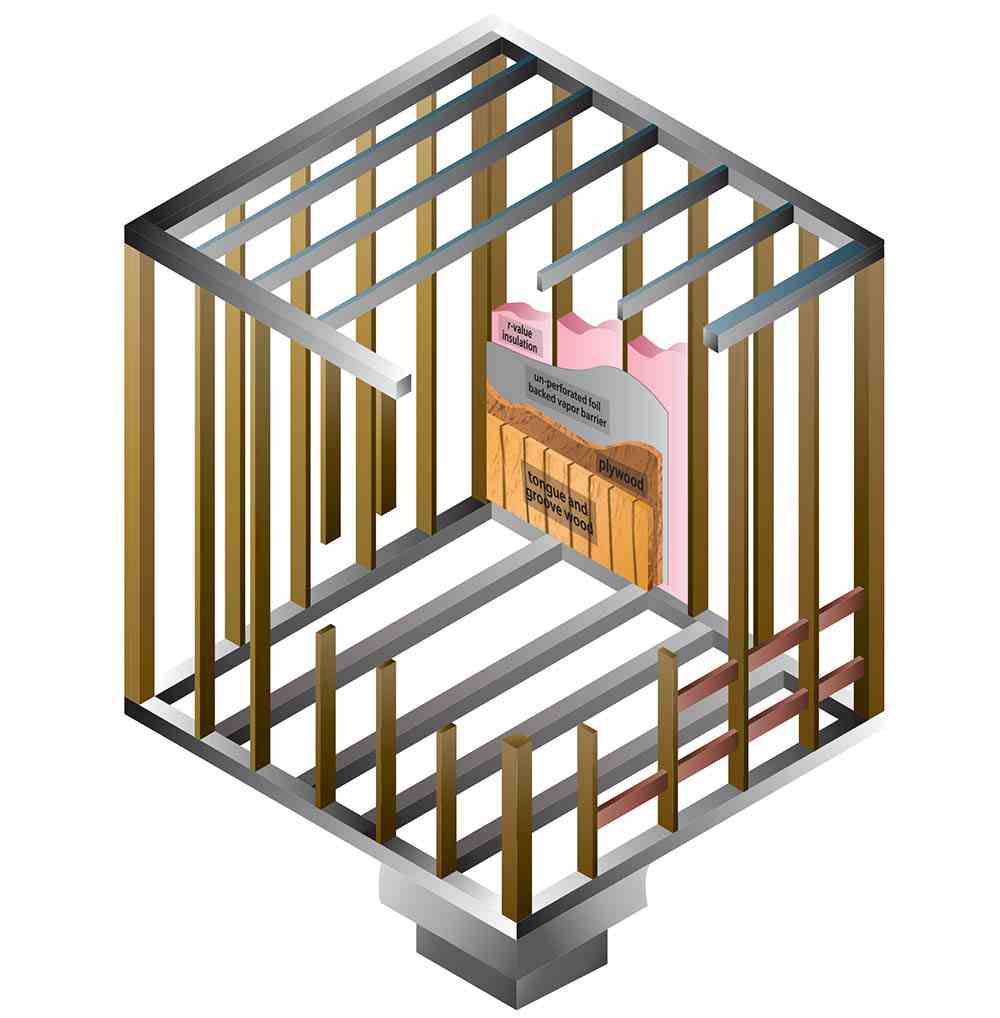
Laying Tongue and Groove Wood
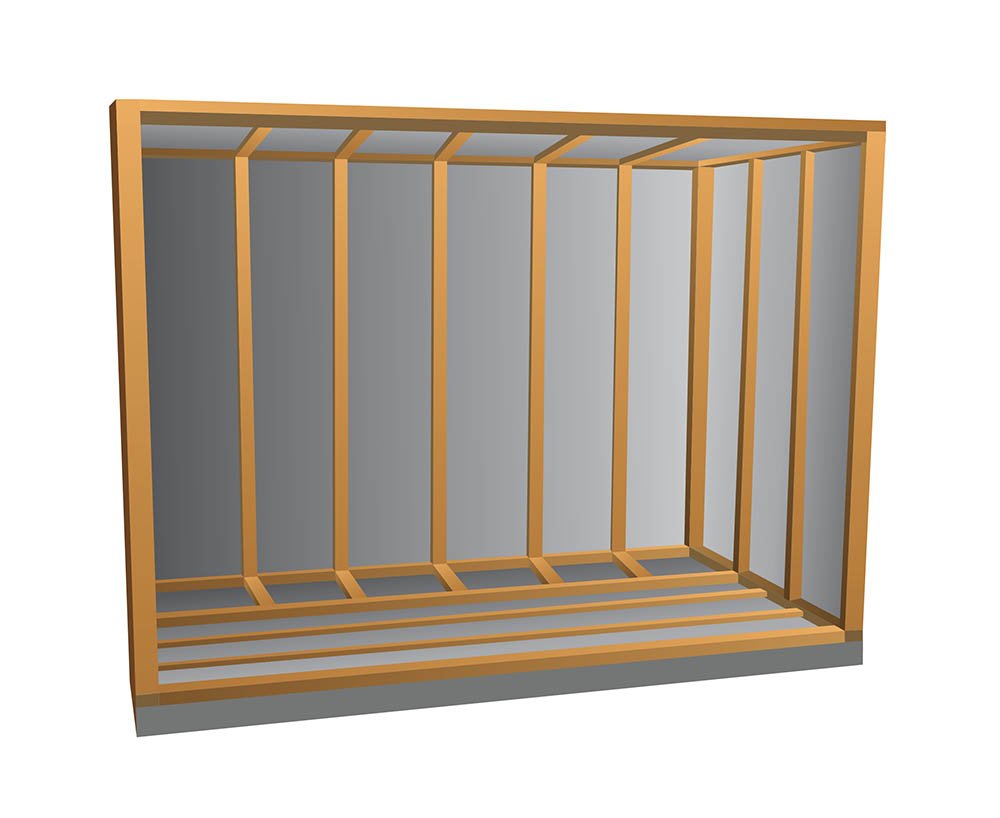
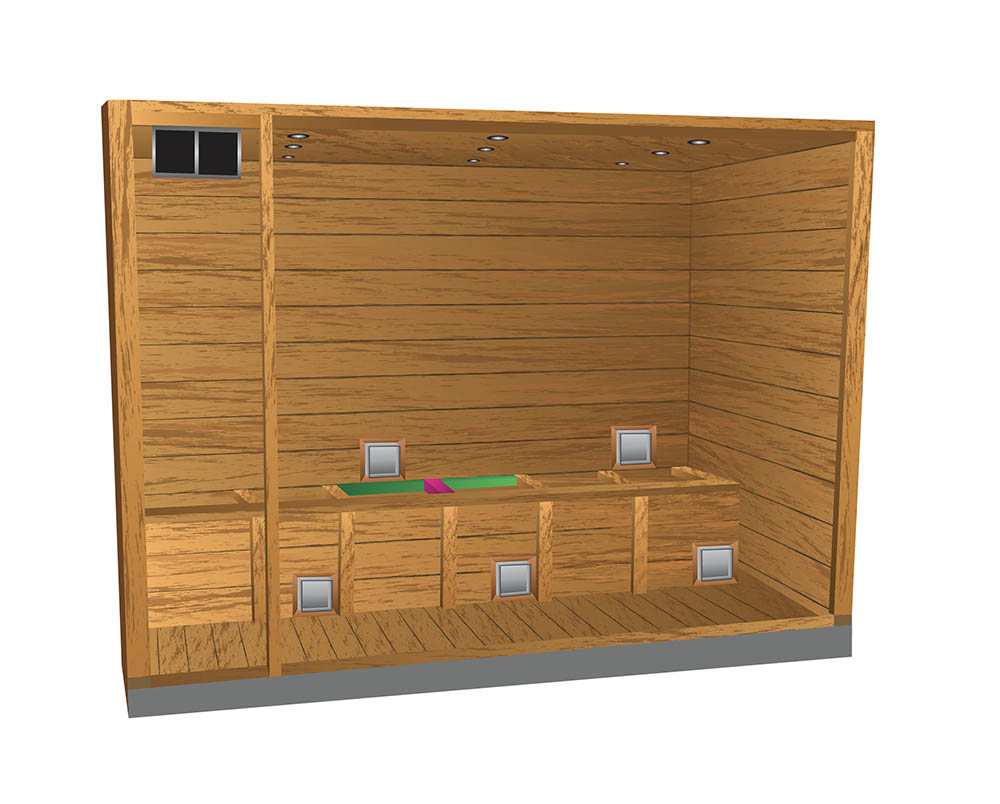
Bench Sub-framing Construction
When building the subframe for the bench, secure the framing to the wall studs for maximum stability and support. Refer to the spec sheet for the finished bench dimensions. Sauna Cloud Infrared Saunas® does not supply any wood for bench construction unless otherwise requested–please speak with your contractor.
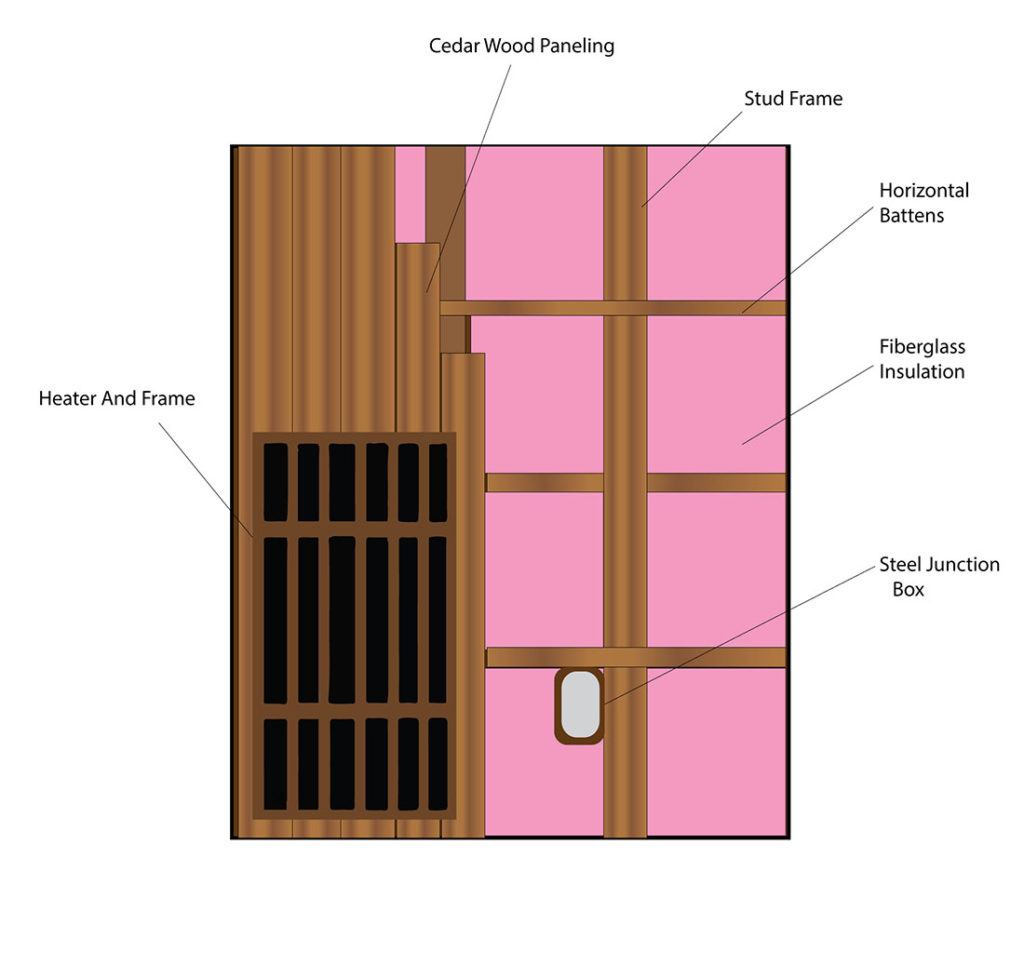
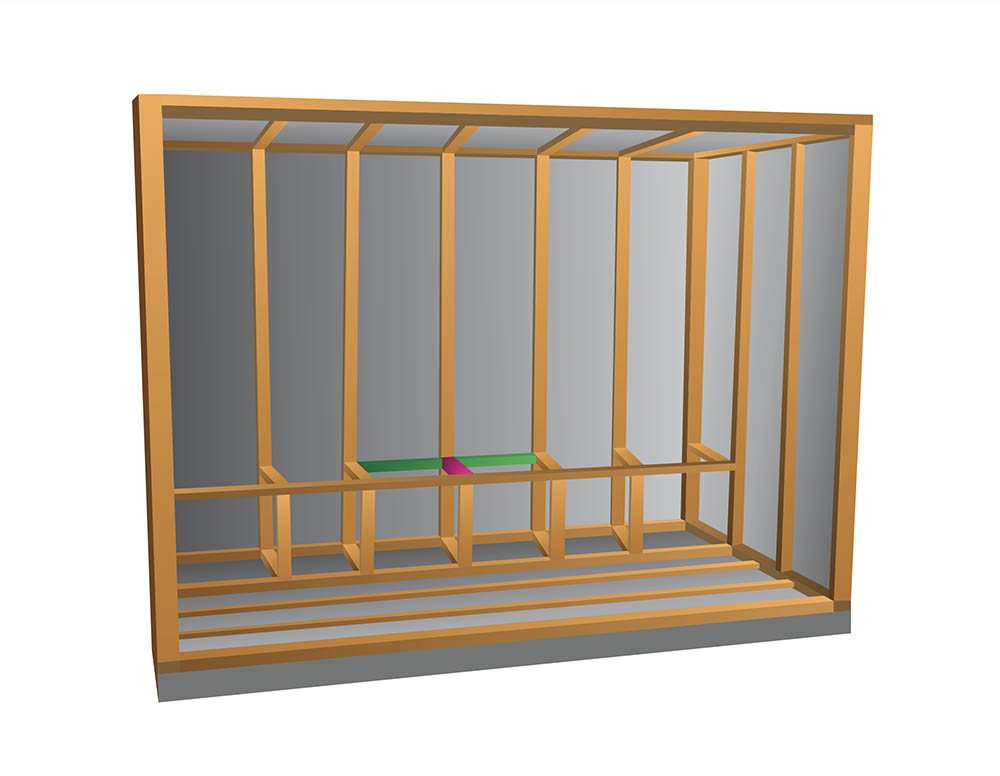
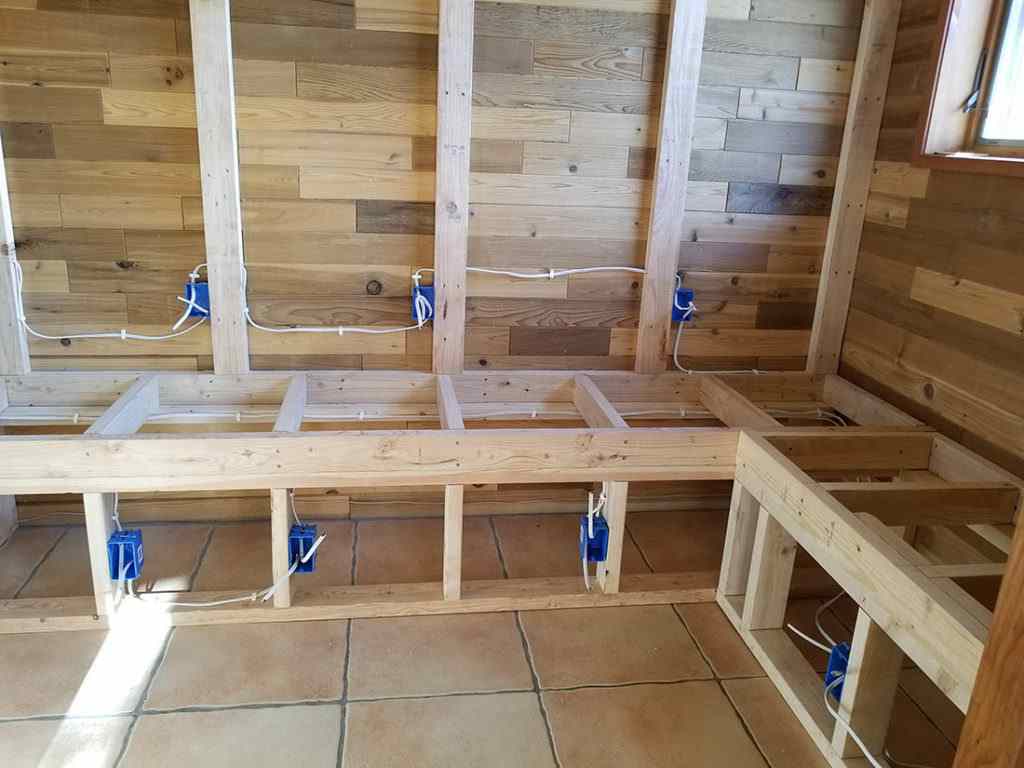
Flip Bench Construction
The power supply box will require access should the system ever need to be serviced by an electrician. Creating a flip bench is the recommended way to allow for access. It is also recommended for commercial installation to add a lock to prevent tampering, injury or damage.
You can also have a bench seat that is removable this is not advised for commercial or rental properties. The flip bench subframing construction requires a removable support beam ( RED ) that will sit in the cradle system comprised of the 2 x 4” supports ( YELLOW ) to hold the bench. The flip seat should be constructed by adhering S4S to a sheet of plywood see below.
The fixed bench(es) should be comprised of S4S attached to the framework and have no gaps or spacing between boards to prevent sweat or spillage from dripping onto the electronics housed beneath. Then attaching blind hinges ( BLUE ) so that the seat flips open. All other bench seating should also be adhered to plywood ( Burgundy ). All bench sub framing material will need to be supplied by your contractor.
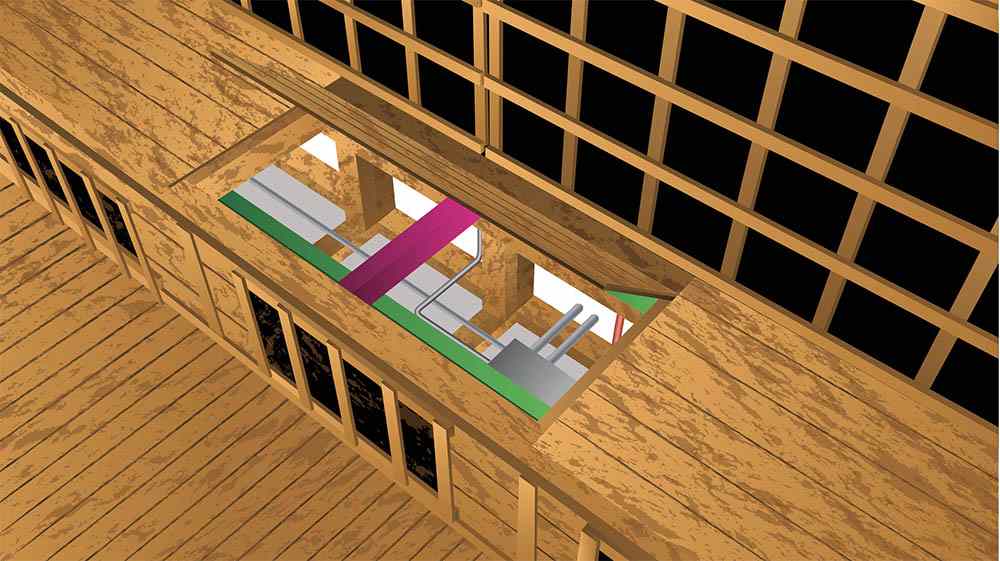
The flip bench seat and the fixed bench(es) should be installed after the electronic components. Here is a completed flip bench from one of our previous saunas:
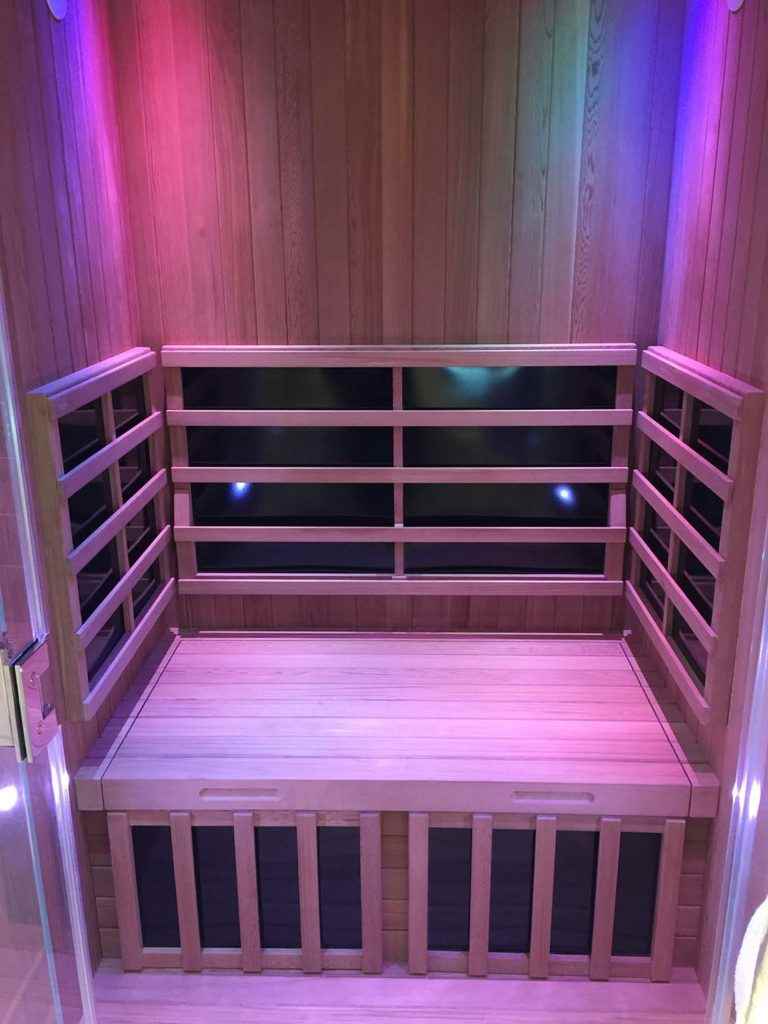
How to Wire Your Custom Infrared Sauna How to Wire Your Custom Infrared Sauna
Now that you’ve framed your room and installed your wood it’s time to wire your sauna. The following chapters will guide you along your way.
Electrical Codes Must Be Followed
Electrical codes are enforced to make sure that electrical installations work properly and are safe. Inspectors don’t play around when it comes to this important topic. Make sure you check your county’s electrical codes and have your sauna inspected.
Additionally, a licensed electrician is required to hard-wire your power supply.
How the Electrical System Works
Electricity is a flow of electrons through a wire conductor.
The electric current in a circuit travels in a loop from one wire as “hot” (usually black or red) and returns through the other wire as “neutral” (usually white). When the circuit is broken, the current ceases.
The system is grounded to prevent a user from being shocked from defects in the wiring.
Voltage and amps:
Voltage is electrical pressure exerted by the power source. Most household fixtures use either 120 or 240-volts. The thicker the wire, the less resistance–so there is less energy lost along its length. Amps and watts are two different types of units to quantify electric current.
Electricity to your sauna:
Electricity flows from the power company, through high-voltage wires into transformers that reduce the voltage to 120 volts per wire. The wires exit the power source, then enter a service panel where they are divided into circuits and distributed to outlets throughout your home.
Most homes have a three-wire arrangement, with two hot wires carrying electrical current to the home and one neutral wire completing the circuit. Homes with two hot wires are able to run 120-volt and 240 volt appliances. Older homes utilize only one hot wire, limiting the electrical service to 120 volts.
Rough Wiring and Ventilation
When framing the room and bench, identify where to put the power strip/power supply box. The power supply should be enclosed inside/under the bench. This is added to avoid accidental contact with water or other liquid that could spill onto the power supply/power strip.
Keypad location should be determined at this point as well. Will you flush mount the controllers? Will you use one or two controllers? One for the inside and one for the outside of the sauna.
Air should flow into a plenum, hallway or another interior room via a wooden vent inside the sauna. The vent should be able to be opened and closed and within reach of someone who can stand normally in the sauna. Venting to the outside wall of a sauna draws cool air into the space, cooling it and reducing its overall temperature. If you can’t close the vent it can diminish the value of your sauna session.
Wiring the Power Supply
When you bring the service into the power supply box, start with Gnd/L1/N1 or (Gnd/L1/L2/N1). This wire will deliver power to the control board, so do not omit it or the system won’t work.
Here is the wiring diagram:
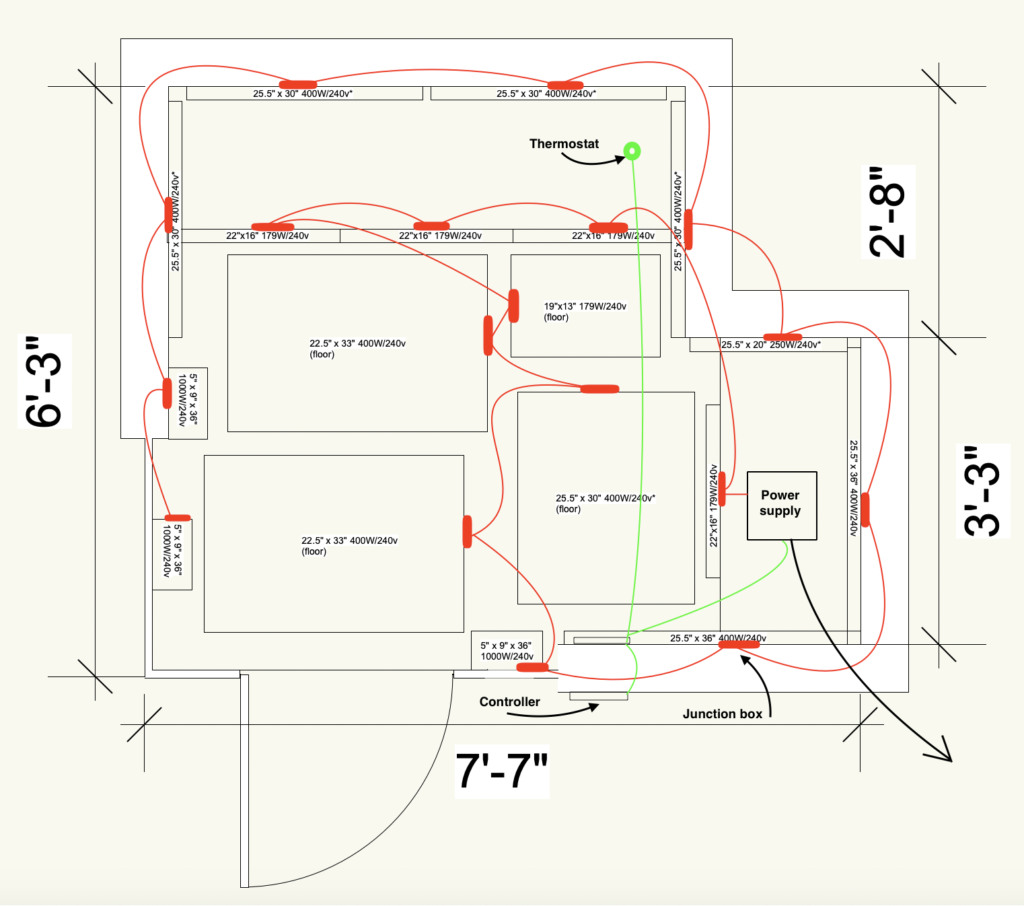
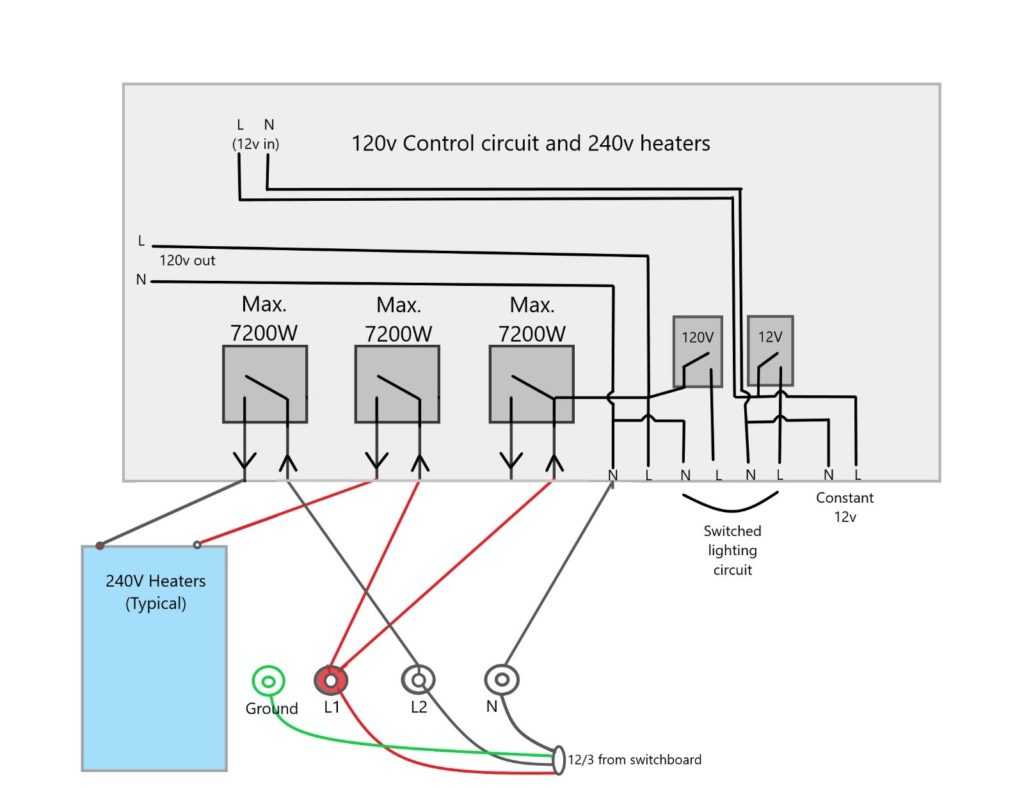
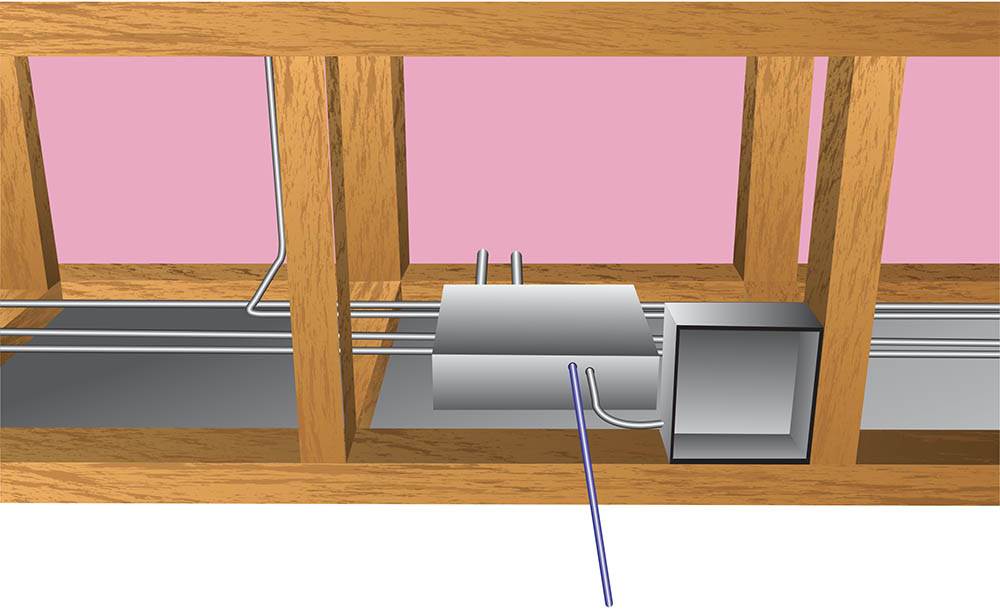
Mounting the Temperature Sensor
Mount the temperature sensor directly opposite where the door opens. This allows it to not be affected by the fluctuation in temperature when the door swings open and closed. When installing a temperature probe, you must insert it ¾” from the finished wall hanging down into the sauna.
Use a low voltage conduit to make the harness more easily replaceable should it need to be down the road. If you need a longer wire for the thermostat, please use figure 8 cable.
Mounting the Control Panels
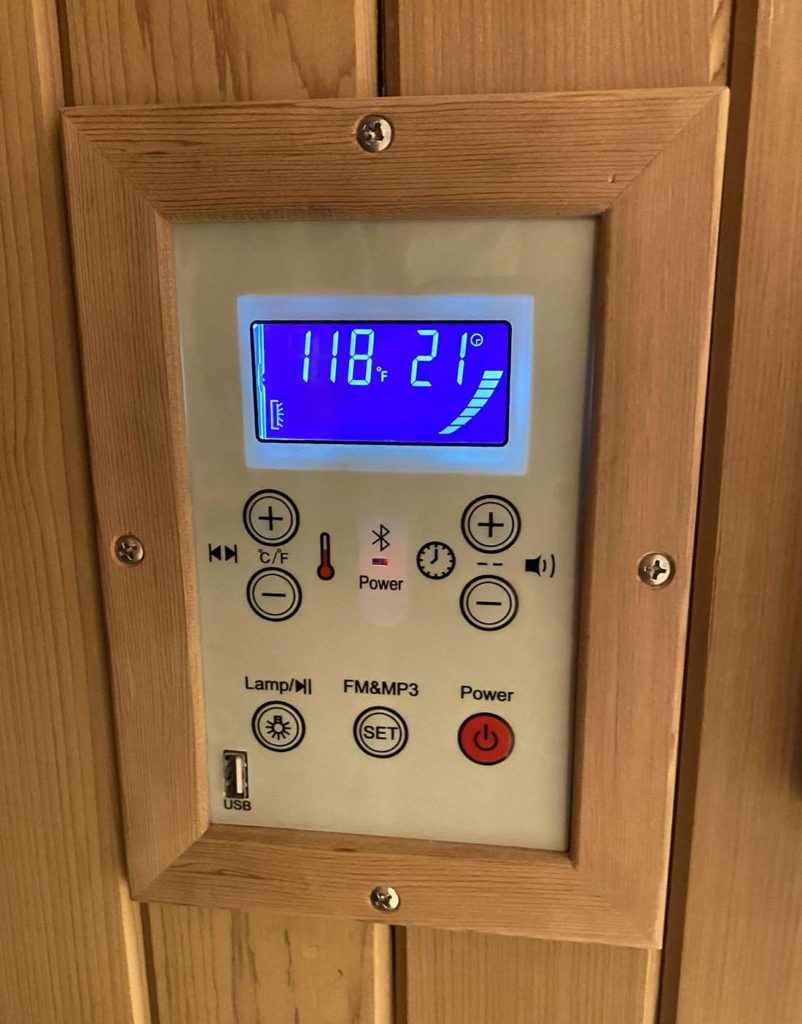
The control cable should go to the location of where the keypad controller will be installed. Choose a low-voltage harness so that the electric cord can be easily replaced should there ever be an issue.
Wiring the Heaters
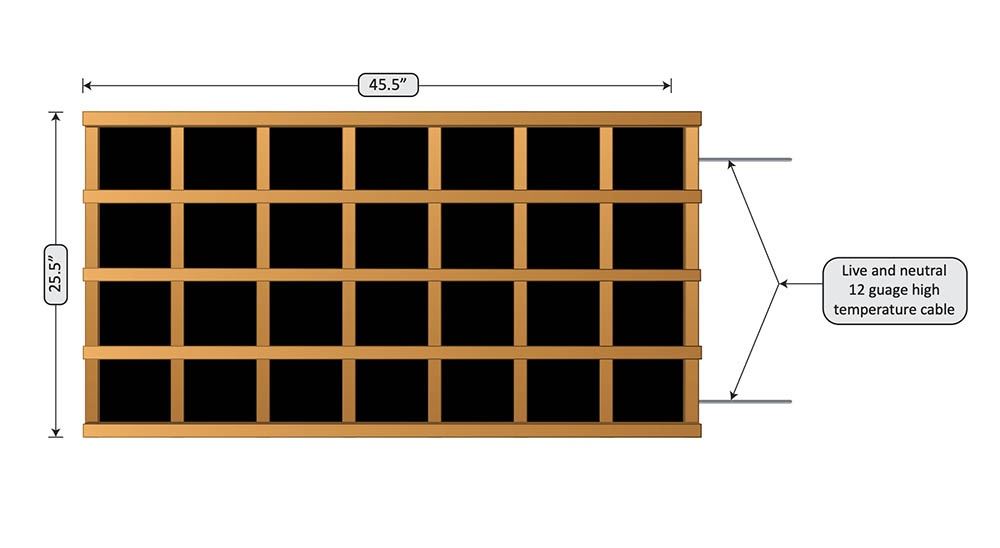
Each heater will require a 2″ x 4” or 4″ x 4” junction box with a cover, proper leads (NM(Romex) or MC) with wire connectors (Marrette). The junction box should be mounted near the start of each lead.
Find a balance between tension and taut, so that the wire avoids being too tight or loose.
Wiring the heaters to the power supply:
Using the NM/MC leads, run theM back into the power supply starting with GND/L1/N or (Gnd/L1/L2). a ground is not necessary for the heaters.
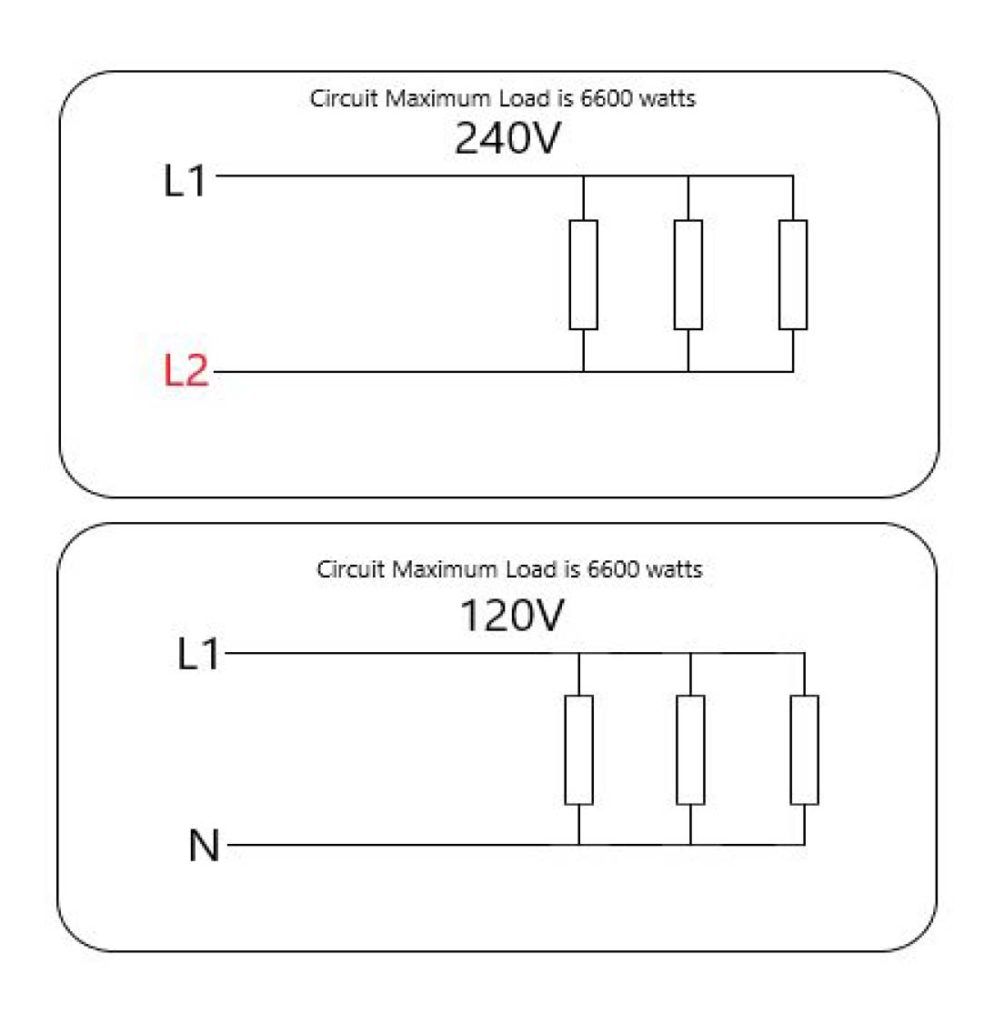
Mounting the Heaters
The heater frames can be drilled through using a 1 3/4″ screw that will screw into the tongue and groove wood. It is up to you if you want to screw through the heater as the 1″ outer edge of the carbon panels can be screwed into.
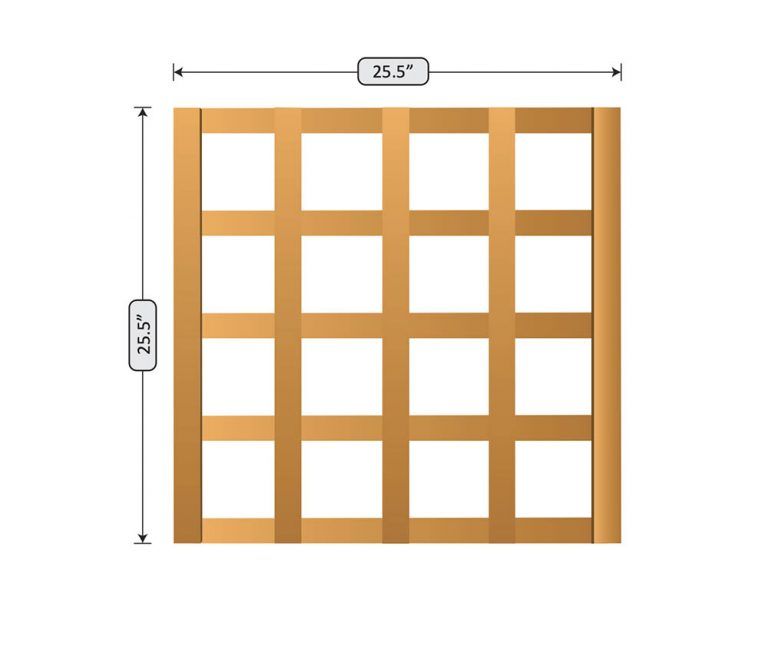

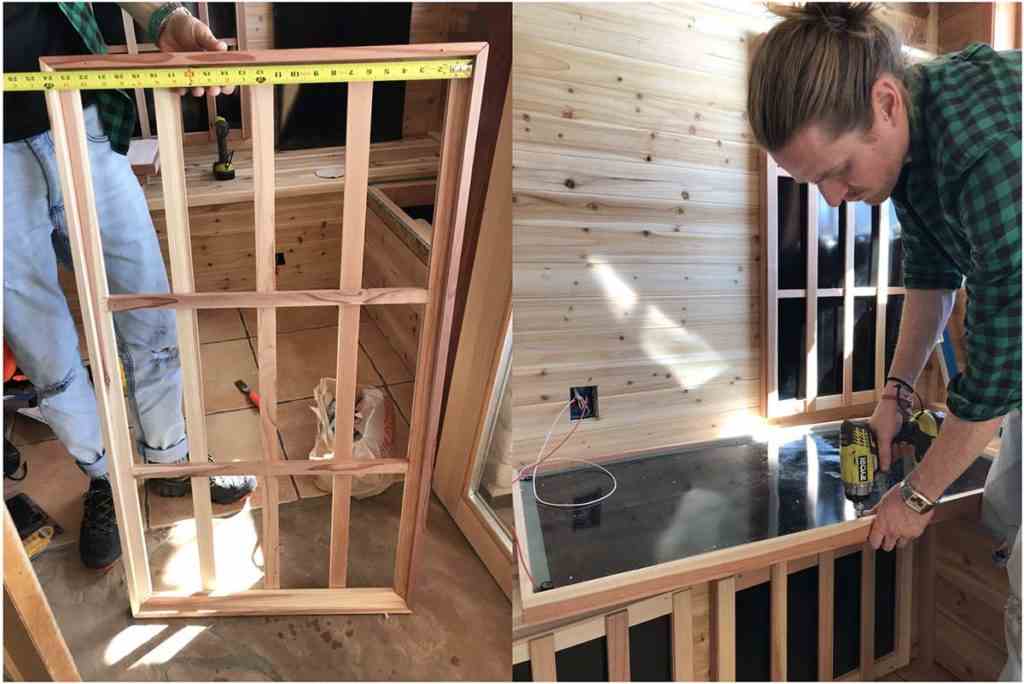
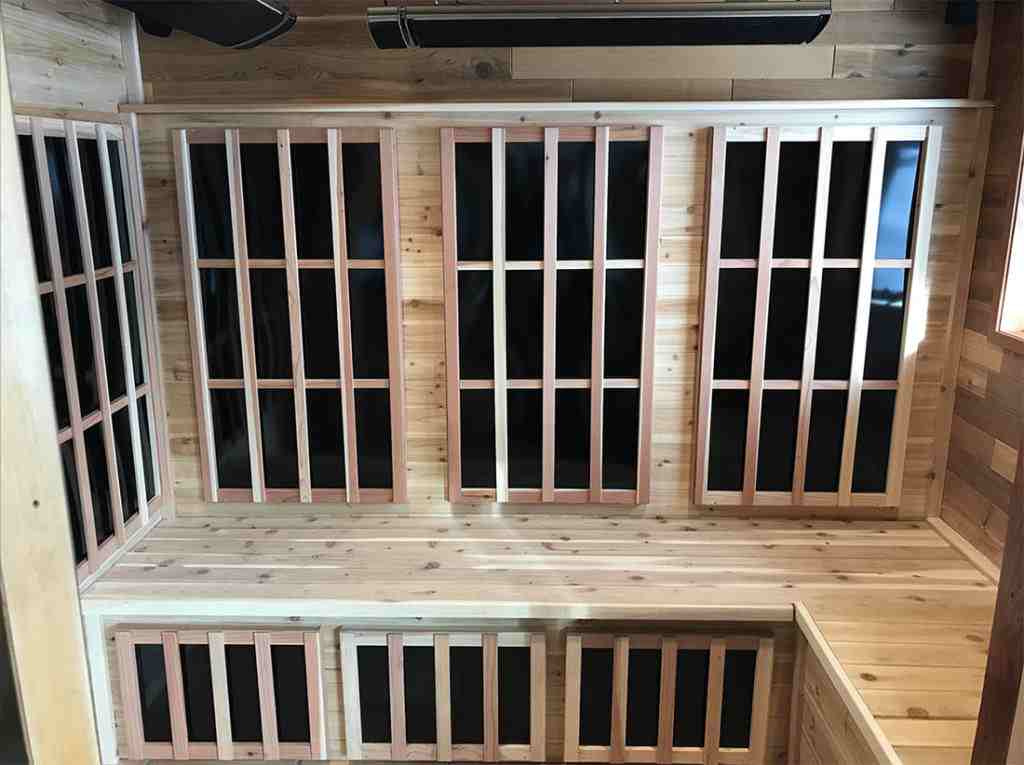
Mounting Infrared Heaters in the Floor
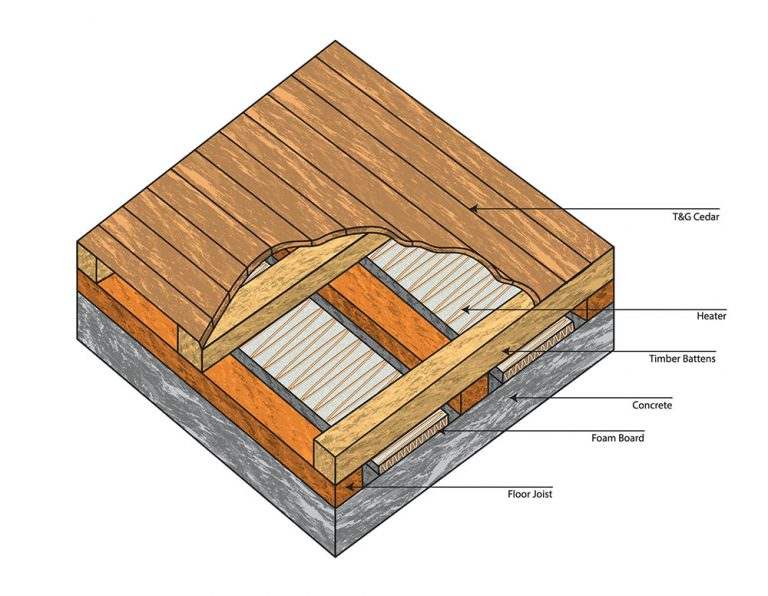
Infrared floor heaters provide a very nice, even heat under your feet so the heating of your body is in unison in your sauna. Please see the following diagrams to mount infrared-heaters under the cedar floor.
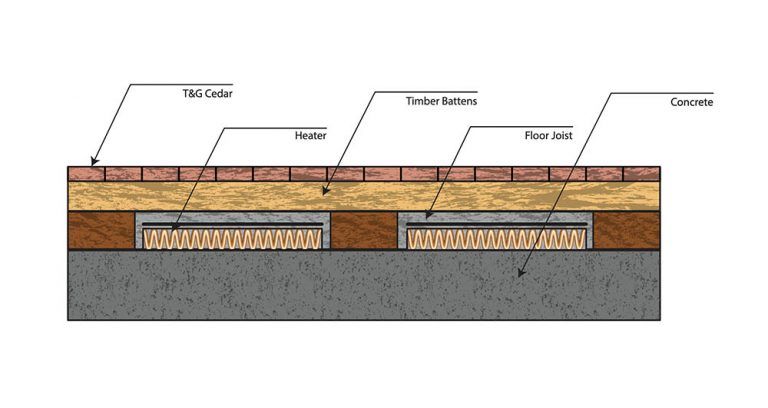
Attaching the Insulation
Ceramic fiber insulation allows for the infrared-heaters to work their best by pointing all of their heat forward, rather than escaping through the back. Attach the insulation by simply putting it on top of the heater which both fit inside of the wooden heater frame.
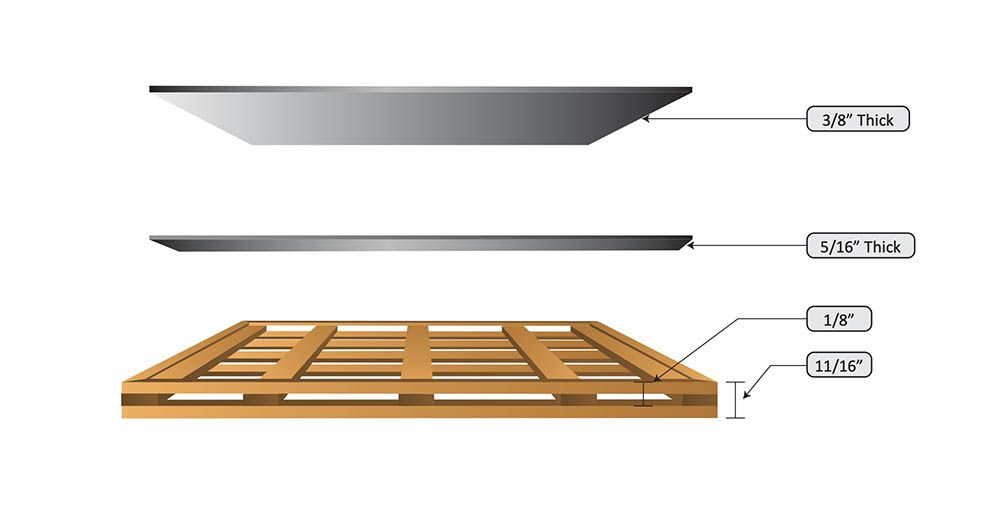
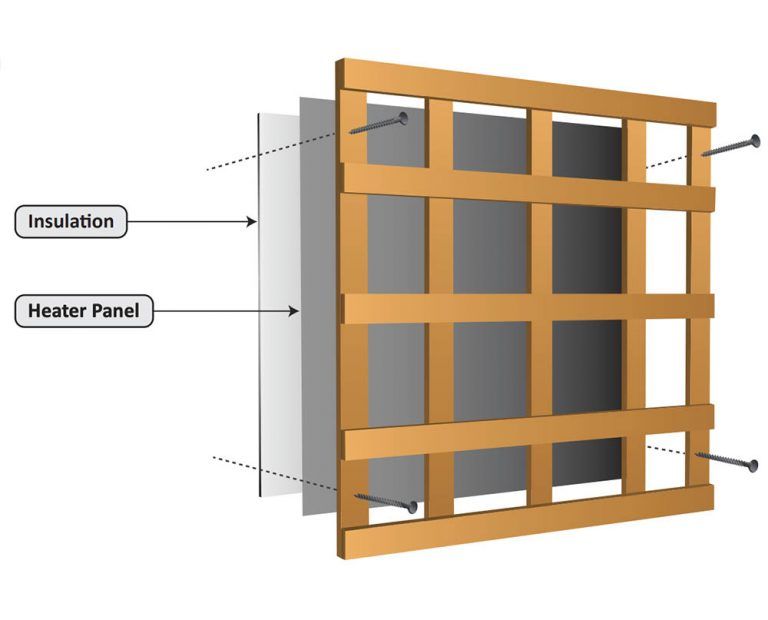
Why Buy from SaunaCloud® Why Buy from SaunaCloud®
Questions to ask before you buy
Frequently Asked Questions Frequently Asked Questions
Is it cheaper to build your own sauna? Is it cheaper to build your own sauna?
How much does it cost to build your own infrared sauna? How much does it cost to build your own infrared sauna?
Can I turn my shower into an infrared sauna? Can I turn my shower into an infrared sauna?
A shower can be converted to an infrared-sauna but upon meeting certain requisite conditions. A proper steam room needs to be maintained for infrared sauna and it must be sealed and enclosed completely.
Is a home infrared sauna worth it? Is a home infrared sauna worth it?
• What is the online reputation of the company you are buying from? Do they have negative reviews/complaints?
SaunaCloud® has only ever received 5-star reviews by offering the best service you can find.
• What is the surface temperature of the carbon panels they are selling?
VantaWave™ Quartz/Graphite heaters reach 200 F° making them the hottest carbon based panels by 25x.
• Is a company pushing a generic “heater kit” that works in many types of sauna sizes?
SaunaCloud® customizes every sauna to make sure it’s not only beautiful but makes you actually sweat!
• Are they offering Full Spectrum heaters? It is impossible to heat infrared saunas with just a carbon infrared sauna heaters.
We are the only company selling Full Spectrum heaters in a custom sauna application.
• Are they pushing a different type of wood than cedar (like eucalyptus or hemlock)? This is to cut their cost. Says a lot about what kind of products you will receive.
We only use the finest Vertical Grain, Western Red Canadian Cedar with no knots! You won’t find a more beautiful wood.
• Is the company you are buying from the sauna manufacturer? How long have they been in business? What is their level of service after the sale? Do they only try to sell you the infrared bulbs?
• What is their warranty? Companies dictate the length of their warranty with how long they believe their heaters to last.
SaunaCloud® has the longest warranty in the industry at 10 years.


